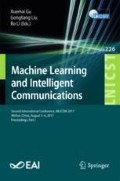Abstract
Automatic modulation classification (AMC) plays an important role in many fields to identify the modulation type of wireless signals. In this paper, we introduce deep learning to signal recognition. Based on architecture analysis of the convolutional neural network (CNN), we used real signal data generated by instruments as dataset, and proposed an improved CNN architecture to achieve compatible recognition accuracy of modulation classification. According to various conditions of signal noise ratio (SNR), we test the proposed CNN architecture with the real sampled signals. Experiments results show that the high-layer network is not necessary for modulation recognition with high SNR signals. The proposed CNN architecture has higher average classification accuracy than RESNET and is more compatible for modulation classification of signals with lower SNR.
Access this chapter
Tax calculation will be finalised at checkout
Purchases are for personal use only
References
Hazza, A., Shoaib, M., Alshebeili, S.A., Fahad, A.: An overview of feature-based methods for digital modulation classification. In: 2013 1st International Conference on Communications, Signal Processing and Their Applications, pp. 1–6. IEEE Press, New York (2013)
Zhu, X., Fujii, T.: A modulation classification method in cognitive radios system using stacked denoising sparse autoencoder. In: 2017 IEEE Radio and Wireless Symposium, pp. 218–220. IEEE Press, New York (2017)
Dai, A., Zhang, H., Sun, H.: Automatic modulation classification using stacked sparse auto-encoders. In: 13th IEEE International Conference on Signal Processing, pp. 248–252. IEEE Press, New York (2017)
Mendis, G.J., Wei, J., Madanayake, A.: Deep learning-based automated modulation classification for cognitive radio. In: 2016 IEEE International Conference on Communication Systems, pp. 1–6. IEEE Press, New York (2016)
He, K., Zhang, X., Ren, S., Sun, J.: Deep residual learning for image recognition. In: 29th IEEE Conference on Computer Vision and Pattern Recognition, CVPR 2016, pp. 770–778. IEEE Press, New York (2016)
Krizhevsky A., Sutskever I., Hinton G.E.: ImageNet classification with deep convolutional neural networks. In: 26th Annual Conference on Neural Information Processing Systems, vol. 25, no. 2, pp. 1097–1105. ACM, New York (2012)
Tang, Y., Eliasmith, C.: Deep networks for robust visual recognition. In: 27th International Conference on Machine Learning, pp. 1055–1062. ACM, New York (2010)
Bengio, Y., Simard, P., Frasconi, P.: Learning long-term dependencies with gradient descent is difficult. IEEE Trans. Neural Netw. 5, 157–166 (1994). IEEE Press, New York
Glorot, X., Bengio, Y.: Understanding the difficulty of training deep feedforward neural networks. In: 13th International Conference on Artificial Intelligence and Statistics, AISTATS 2010, pp. 249–256. Microtome Publishing, Brookline (2010)
Srivastava, N., Hinton, G., Krizhevsky, A., Sutskever, I., Salakhutdinov, R.: Dropout: a simple way to prevent neural networks from overfitting. J. Mach. Learn. Res. 15, 1929–1958 (2014). Microtome Publishing, Brookline
Acknowledgement
This work was supported by National Natural Science Foundation of China. (No. 61601147, No. 61571316, No. 61371100) and the Fundamental Research Funds for the Central Universities (Grant No. HIT. MKSTISP. 2016013).
Author information
Authors and Affiliations
Corresponding author
Editor information
Editors and Affiliations
Rights and permissions
Copyright information
© 2018 ICST Institute for Computer Sciences, Social Informatics and Telecommunications Engineering
About this paper
Cite this paper
Xu, Y., Li, D., Wang, Z., Liu, G., Lv, H. (2018). A Deep Learning Method Based on Convolutional Neural Network for Automatic Modulation Classification of Wireless Signals. In: Gu, X., Liu, G., Li, B. (eds) Machine Learning and Intelligent Communications. MLICOM 2017. Lecture Notes of the Institute for Computer Sciences, Social Informatics and Telecommunications Engineering, vol 226. Springer, Cham. https://doi.org/10.1007/978-3-319-73564-1_37
Download citation
DOI: https://doi.org/10.1007/978-3-319-73564-1_37
Published:
Publisher Name: Springer, Cham
Print ISBN: 978-3-319-73563-4
Online ISBN: 978-3-319-73564-1
eBook Packages: Computer ScienceComputer Science (R0)

